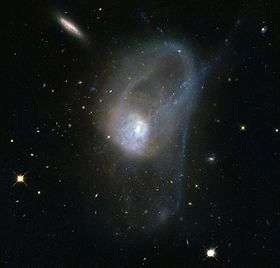NGC 3921
| NGC 3921 | |
|---|---|
 NGC 3921, imaged by the Hubble Space Telescope | |
| Observation data (J2000 epoch) | |
| Constellation | Ursa Major |
| Right ascension | 11h 51m 06.863s[1] |
| Declination | +55° 04′ 43.38″[1] |
| Redshift | 0.019667[2] |
| Helio radial velocity | 5896 km/s[2] |
| Distance | 277.9 Mly (85.19 Mpc)[3] |
| Apparent magnitude (V) | 12.64[4] |
| Apparent magnitude (B) | 13.4[4] |
| Absolute magnitude (V) | −22.09[5] |
| Characteristics | |
| Type | (R')SA0/a(s) pec[2] |
| Size | 180,200 ly (55,240 pc)[2][note 1] |
| Apparent size (V) | 2.1′ × 1.3′ |
| Other designations | |
| Arp 224, UGC 6823, MGC+09-20-009, PGC 37063 | |
NGC 3921 is a galaxy in the northern constellation of Ursa Major. Estimates using redshift put the galaxy at about 59 million light years (18 megaparsecs) away.[3] It was discovered on 14 April 1789 by William Herschel,[6] and it was described as "pretty faint, small, round" by John Louis Emil Dreyer, the compiler of the New General Catalogue.[7]
NGC 3921 is the remnant of a galaxy merger. The two progenitor galaxies are thought to have been disk galaxies that collided about 700 million years ago.[8] The image shows noticeable star formation and structures like loops, indicative of galaxies interacting.[8] Because of this, NGC 3921 was included in Halton Arp's Atlas of Peculiar Galaxies under the designation Arp 224.[4]
Being a starburst galaxy, NGC 3921 has important features. One of them is an ultraluminous X-ray source, designated X-2, with an X-ray luminosity of 8×1039 erg/s.[9] Additionally, two candidates globular clusters have been detected within NGC 3921.[5] They are both fairly young, and are about half as massive as Omega Centauri: this demonstrates that mergers of gas-rich galaxies can also create more metal-rich globular clusters.[5]
References
- 1 2 Skrutskie, M. (2006). "The Two Micron All Sky Survey (2MASS)". The Astronomical Journal. 131 (2): 1163–1183. Bibcode:2006AJ....131.1163S. doi:10.1086/498708.
- 1 2 3 4 "NED results for object NGC 3921". National Aeronautics and Space Administration / Infrared Processing and Analysis Center. Retrieved 28 May 2017.
- 1 2 Crook, Aidan C.; Huchra, John P.; Martimbeau, Nathalie; Masters, Karen L.; Jarrett, Tom; Macri, Lucas M. (2007). "Groups of Galaxies in the Two Micron All Sky Redshift Survey". The Astrophysical Journal. 655 (2): 790. arXiv:astro-ph/0610732. Bibcode:2007ApJ...655..790C. doi:10.1086/510201.
- 1 2 3 "NGC 3921". SIMBAD. Centre de données astronomiques de Strasbourg. Retrieved 28 May 2017.
- 1 2 3 Schweizer, François; Seitzer, Patrick; Brodie, Jean P. (2004). "Keck Spectroscopy of Two Young Globular Clusters in the Merger Remnant NGC 3921". The Astronomical Journal. 128: 202. arXiv:astro-ph/0404424. Bibcode:2004AJ....128..202S. doi:10.1086/421851.
- ↑ Seligman, Courtney. "New General Catalogue objects: NGC 3900 - 3949". cseligman.com. Retrieved 28 May 2017.
- ↑ "Revised NGC Data for NGC 3921 - Hartmut Frommert - SEDS". seds.org. Retrieved 28 May 2017.
- 1 2 "Evolution in slow motion | ESA/Hubble". www.spacetelescope.org. 2015. Retrieved 28 May 2017.
- ↑ Jonker, P. G.; Heida, M.; Torres, M. A. P.; Miller-Jones, J. C. A.; Fabian, A. C.; Ratti, E. M.; Miniutti, G.; Walton, D. J.; Roberts, T. P. (2012). "The Nature of the Bright Ulx X-2 in Ngc 3921: Achandraposition Andhstcandidate Counterpart". The Astrophysical Journal. 758: 28. arXiv:1208.4502. Bibcode:2012ApJ...758...28J. doi:10.1088/0004-637X/758/1/28.
Notes
- ↑ POSS1 103a-O values used.